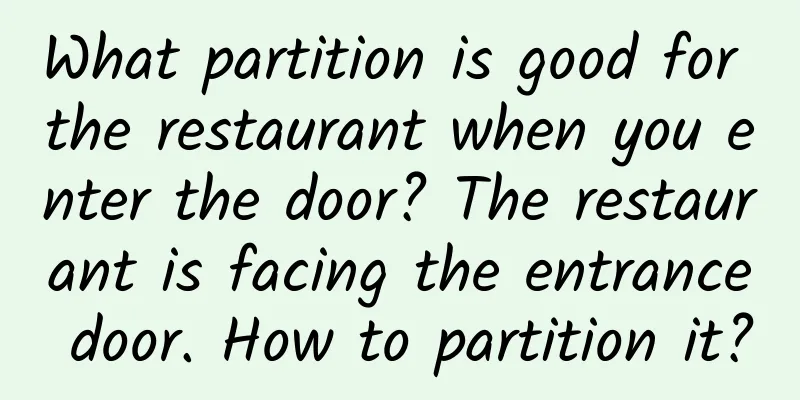What partition is good for the restaurant when you enter the door? The restaurant is facing the entrance door. How to partition it?

|
We all know that different houses have different areas and different layouts. Some houses face the living room as soon as you enter the door, some houses face the corridor as soon as you enter the door, and some houses face the dining room as soon as you enter the door, etc. So how to design the partition when the dining room is right at the entrance? Let's take a closer look! How to partition the restaurant when the door opensRestaurant booth partitionThe entrance faces the dining room directly, and a booth is placed 1-1.2 meters in front of the door, with a glass partition or hollow partition above. A shoe cabinet is placed on the left or right side of the door. If there is no suitable space on the left or right side, you can make the shoe cabinet, booth and partition together. One side is the booth and the other side is the shoe cabinet. Craft glass partitionMake a glass partition between the entrance and the dining room, which has better transparency. Make it translucent glass or craft glass, which is light-transmissive and has a certain decorative effect. Fully blocked partitionWooden boards are used for decoration and can completely block the partitions of the restaurant, providing better privacy for the restaurant. However, the light in the foyer will be poor and will require lighting assistance. Cabinet partitionUsing a shoe cabinet or wardrobe at the entrance as a partition is practical but rather bulky. Screen partitionUse a wooden frame and then use translucent paper or cotton sand embroidery to make screen partitions. Indoor window partitionUse it as a partition in the form of an indoor window, and make a shoe cabinet under the window. This kind of window should be made more beautiful inside. There are many forms of partitions, and you can design them according to your own situation. It is best not to install partitions if possible. Partitions also take up indoor space. For houses that are not large, try not to install them unless it is absolutely necessary. The partition design of the restaurant is right outside the doorThere are generally two situations when you can see the restaurant when you open the door: the restaurant is directly opposite the entrance door or the restaurant is on one side of the entrance door. 1. The restaurant is directly opposite the entrance doorThe dining room is directly opposite the entrance door. I think there are several ways to set up the partition: the partition is in the "front" and the dining room is in the "back"; the dining room is on the "left" and the partition is on the "right"; the partition is in the "back" and the dining room is in the "front" and the foyer is used as the "partition". ⑴The partition is in the "front" and the restaurant is in the "back" The partition is set in the "front" of the dining room, dividing the original dining room space "into two". "One space" is used as the entrance area, enriching the functional areas of the family space, "buffering" the sense of urgency of seeing the dining room as soon as entering the house, and effectively avoiding the embarrassing phenomenon of shoe cabinets, shoe-changing benches, clothes hangers and other functions being "mixed into one" with the dining room, giving them their own "exclusive area"; the other space is still used as a dining room, and the dining table, dining chairs, sideboards and other functions are selected according to the functional needs and area of the family. If the entrance area is large, the partition and the functional objects (such as shoe cabinets) can be set separately, and the style of the partition can be more freely selected; if the entrance area is small, the partition and the shoe cabinet can be set "integrated" to save space and "one object for multiple uses", but because it needs to be "connected" to other objects, the style of the partition will be limited to a certain extent... ⑵The restaurant is on the "left" and the partition is on the "right" The restaurant is small and close to the entrance, so you can choose to set the partition on one side of the restaurant. It will not "reduce" the area of the restaurant area, creating a cramped feeling at the entrance, and will also have a certain degree of "blocking" effect on the family space. Since it is close to the entrance, a shoe cabinet can be set up as a "partition", which solves the "awkward situation" of no space for the shoe cabinet and is convenient to use; when there is a booth in the restaurant, the depth of the booth can be used to set up an "embedded" shoe cabinet, and the restaurant and shoe cabinet become "one", which can make the shoe cabinet achieve a better "invisible" effect and weaken the "presence" of the shoe cabinet! ⑶The partition is at the "back" and the restaurant is at the "front" If the dining table needs a "backbone", or the area adjacent to the dining room needs to be used (for example, the living room area connected to the dining room needs a TV wall, and a partition is set up to be used as a TV wall), or if you want to separate the dining room from the adjacent area, you can choose to put the partition at the "back" and the dining room at the "front". However, if the dining area is small and close to the entrance, it is easy to create a sense of chaos at the entrance, and it needs to be tidied up in time. The partition does not have to be set "near" the entrance door. Finding a suitable location is the most important thing... ⑷Build a foyer as a "partition" Constructing a foyer at the entrance to serve as a "partition" will give the family a sense of "ritual" when entering the house. The installation of shoe cabinets, shoe-changing benches, clothes hangers and other functional facilities will make the foyer more "fuller". However, since the foyer has a strong spatial nature and a small area, it may feel cramped. Partitions or shapes with better "sense of transparency" can alleviate this situation to a certain extent. 2. The restaurant is on the side of the entrance doorThe dining room is on one side of the entrance door, and the living room and dining room are on both sides of the entrance door. The living room and dining room are on one side of the entrance door, and the living room and dining room are arranged "upper and lower". Different apartment types have different ways of setting up partitions. ⑴ The living room and dining room are on both sides of the entrance door The living room and dining room are on both sides of the entrance door. I think the partition can be set up in two ways: on the dining room side or on the living room side, perpendicular to the wall, and opposite to the entrance door. ① The partition is set on the dining room side or the living room side perpendicular to the wall In the apartment with the living room and dining room on both sides of the entrance door, it is a common method to set the partition perpendicular to the wall on the dining room or living room side. I think you can refer to the following points to choose which side to set the partition: the area of the area, because the setting of the partition will limit the functional area to a certain range. If the area is small, the partition with poor "transparency" will make it feel cramped, so I think the partition is more suitable to be set on the side with a larger area; living habits, the partition with use function (such as shoe cabinet partition) should be set on the side of the living room or dining room according to living habits, and it is also important to use it conveniently in the family; personal preference, the first thing you see when entering the house is the functional area without partitions, and the functional area with partitions will be temporarily "hidden", so which side you like to see when entering the house, set the partition on the other side; apartment type, sometimes one side of the house will be seen when opening the door to enter the house, set the partition on the side of the functional area to block it... When setting up a partition on one side of the living room, you need to pay attention to the width of the partition. A partition that is too wide will "hinder" the placement of furniture in the living room area, so the width of the partition is usually equal to or slightly larger than the width of the adjacent furniture... ②The partition is set opposite the entrance door The partition is set between the living room and the dining room, facing the entrance door. It can block the more private "quiet area" in the home (such as the bedroom, study and other quieter gathering areas in the home), effectively avoiding the situation where the home is "unobstructed"; it can create a high-end and atmospheric space effect, and is also suitable for the house type where the entrance door and other functional space doors (such as bedrooms and bathrooms) are opposite... As the partition is set between the living room and the dining room, facing the entrance door, the width of the partition needs to be ensured to be wider than the entrance door, while leaving enough space on both sides for normal use of two areas. I think this size is determined by the size of the furniture and the number of people living in the house for a long time. About 1.2m can allow two people to pass through at the same time. ⑵The guest room and dining room are on the same side For apartments with the living and dining rooms on the same side, partitions are usually installed vertically with the wall on one side of the living and dining rooms to block the use of space. ⑶ The guest room and dining room are arranged in an "upper and lower" manner For a house with the living and dining rooms arranged up and down, I think there are two ways to set up partitions: one is to have the partition facing the entrance door, and the other is to form a foyer. ①The partition faces the entrance door The partition is set directly opposite the entrance door, which is generally used to "block" the living room space to a certain extent, avoiding the embarrassment of the living room area and the entrance door being "naked"... I think the width of the partition should only be enough to cover the furniture opposite the entrance door... ②Build a foyer as a "partition" Use furniture, partitions, walls, or a combination of walls and partitions to build a foyer, "hide" the living room, and "define" the dining area, so that there will no longer be a sense of urgency in the entrance area... The partition style of the restaurant is right when the door is openedI think you can choose a partition that suits your home based on the size of your home, functional requirements, decoration style, and personal preferences, but there are too many styles to list one by one, so I will briefly summarize a few categories: 1. Functional area "partition"⑴ "Use local materials" style. Sometimes the restaurant is "connected" to other functional areas, and you can use "local materials" to build the functional area into a "partition". For example, if the restaurant is "adjacent" to the kitchen, the kitchen can be transformed into an open style, and the cabinets can be used as "partitions" either opposite to the entrance door or on the side of the entrance door... ⑵ New construction. A new functional area is built according to the functional needs, personal preferences, and space area of the family as a "partition". Because it is a "new construction", the type of functional area can be chosen more freely, but it is important to pay attention to the height of the part of the functional area used as a "partition". A "half-height" style will keep the family space "unobstructed", while a "floor-to-ceiling" style will make this effect "disappear" and even bring a sense of crampedness. The newly built bar area not only enriches the use functions of the family, but also the bar and the chandelier complement each other and become a "partition" between the restaurant and the entrance area. The space has a strong sense of hierarchy, is flexible, and has a good decorative effect... 2. Storage cabinet partitionStorage cabinet partitions are used frequently and are also a practical style when set up in the entrance area. ⑴ "Solid" style. "Solid" storage cabinets are used as "partitions". "Floor-to-ceiling" styles will have a good shielding effect on the space, with a large storage space, which is practical, but it is also easy to make a small space feel cramped, so you need to be careful when choosing; the shorter "solid" storage cabinet will not have this situation, and it will bring a better sense of hierarchy to the space, but its shielding and partitioning effect on the space is "weaker", so it needs to be selected according to the functional needs of the family. For example, when the cabinet is set on one side of the entrance door to avoid being seen when the door is opened, the "floor-to-ceiling" "solid" storage cabinet will be more suitable... ⑵ "Transparent" style. A storage cabinet with a good "transparent" effect can effectively avoid the feeling of being cramped in the space, and the "transparent" part of the cabinet can be used by the dining area and the entrance area at the same time, which is very convenient! 3. Wall partition⑴ "Low wall" type. The "low wall" type partition with a certain height not only divides the space into two functional areas on the "ground", but also maintains the "integration" of the space in the "air", which will not affect the "spacious" effect of the space... ⑵ "High wall" style. In addition to the functions of separation and shielding, the "high wall" partition that reaches the ceiling is, in my opinion, a partition style that is easier to "integrate" with the family space. It can be decorated in the same way as other walls, hiding itself in the space without being discovered; it can also be "independently decorated" with materials and shapes different from other walls, which will become the most beautiful wall in the home, rather than a "partition"... "High wall" type partitions will form a more "complete" division of the space, so I think it is more suitable for use in larger spaces. When used in smaller spaces, you can reduce its width or match it with partitions of other materials such as wood and iron to reduce the sense of oppression it brings to the space. 4. Decorative partitionsDecorative partitions are made of many materials, including iron, glass, metal, wood, etc. They have almost no practical functions, but have varied shapes and good decorative effects. They are a more "pure" partition style. The door is where the restaurant partition is set up1. Dimensional value reference⑴ The distance between the partition and the entrance door. The distance between the partition and the entrance door should be about 1.2~1.5m, which will neither feel cramped nor waste space. (2) The area of the foyer. The foyer will be more comfortable if the area is about 3~5㎡. 2. The “relationship” between partitions and wallsThere are two types of "relationships" between partitions and walls: the wall-based partition and the "off-wall" partition. The wall-based partition is more stable because it relies on the wall; while the "off-wall" partition can "take the initiative". Its setting no longer needs to "accommodate" the location of the functional area, but can determine the location of the functional area. It will be a good choice to improve the layout of the family. For example, if the location of the dining area is not suitable, you can set a partition in a suitable location and place the dining table against the partition, and the location of the dining area will also be "changed"... Small extension: The setting of partitions must also take into account the area required for the dining area. The following are reference sizes for square, round, and rectangular dining tables that are more commonly used in families. The required sizes for dining chairs and aisles (the width of the aisle is about 1.2m to accommodate two people passing through at the same time) cannot be ignored. |
>>: How about buying a duplex house? What are the advantages and disadvantages of a duplex house?
Recommend
What to do if you drink alcohol during pregnancy
Most people should know that for the health of th...
[Medical Q&A] Can smoking also cause eye diseases?
Planner: Chinese Medical Association Reviewer: Xi...
Can I drink boiled water during confinement? Four dietary taboos explained
In traditional Chinese concepts, confinement is g...
What are the precautions during menstruation?
There are many issues that women need to pay atte...
What causes itchy bumps on the vulva?
In daily life, many female friends will have the ...
Why is the leucorrhea so white like yogurt?
Normal women's secretions are colorless, but ...
What are the pitfalls to watch out for when customizing the whole house? What kind of board is good for customizing the whole house
Many friends don't know what exactly is custo...
Can I perm my hair while breastfeeding?
Hair is an important element that can modify peop...
Is it good for girls to learn Sanda?
Martial arts is a dream of many people. Especiall...
How to treat unruptured ovarian follicles
Unruptured follicles should be taken seriously. W...
Causes of lumbar muscle strain in women
In a family, women are the ones who do the most w...
Can I fill my teeth during my menstrual period?
There are many things that women need to pay atte...
Is it normal to have stomach pain after medical abortion?
Medical abortion is a relatively popular method o...
Gynecological examination cleanliness level 3
Many women have varying degrees of gynecological ...
How to choose garlic sprouts? How to pick garlic sprouts without breaking them
Garlic sprouts are a kind of green vegetable, whi...









